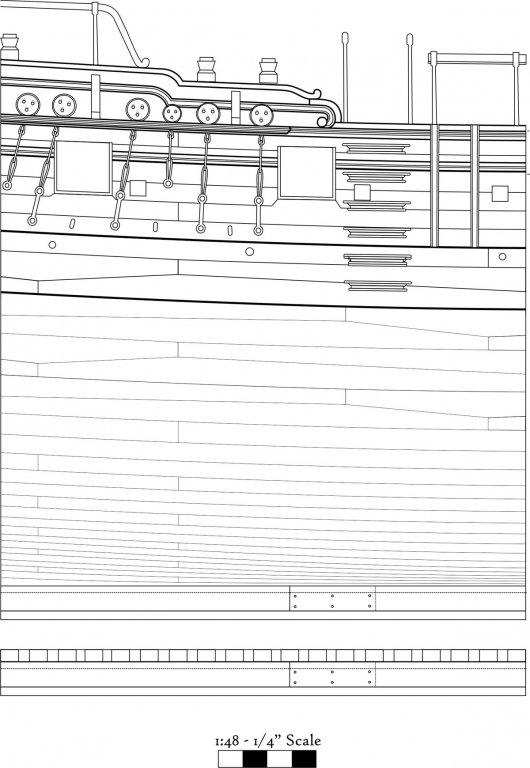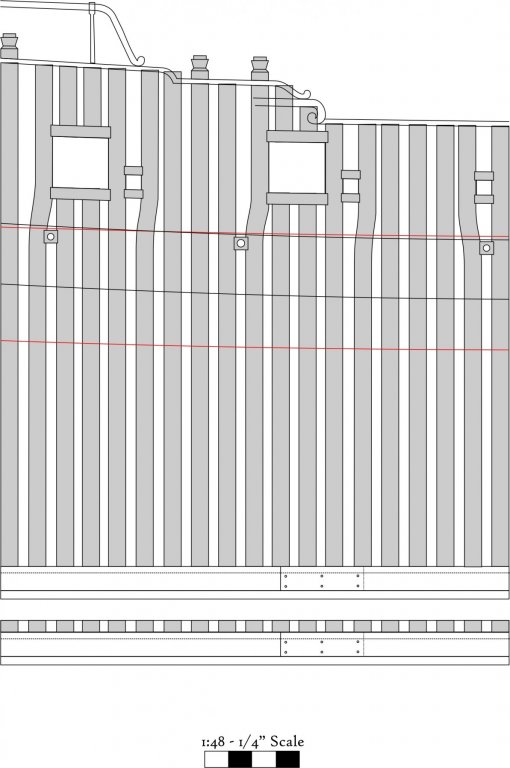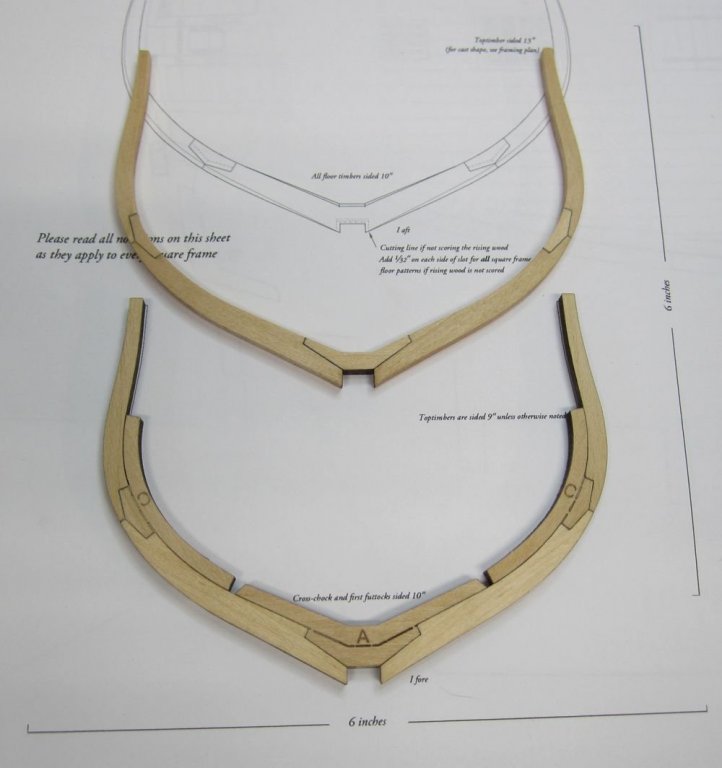-
Posts
9,701 -
Joined
-
Last visited
Content Type
Profiles
Forums
Gallery
Events
Everything posted by Chuck
-
As of right now that is probably not going to happen. Unfortunately laserboard is not strong enough to use for such pieces. Etched brass is also very expensive and something like that could add another 40 bucks to the price of a kit. If I remember correctly that AM sheet was going for around 50. So for now, its just something I need to consider as I get closer to that part of the build. It depends on how expensive the kit is at that time because I would like to keep the kit at around $200 -225 give or take. Anything else would just limit the amount of folks willing to pay for it. Especially as I need to compete with those cheap-o pirated versions of cross sections that folks are buying. If I price this too high it just wont sell. except to a select few who can afford it. I would also like to keep this kit at an intermediate level for new builders dipping their toe into POF modeling. Real POF though..... and not the stylized Hahn stuff or what you see in those kits I mentioned. That is really my main focus. At 1:64 scale I dont even think it is possible. It would just be too small for almost everyone to build never mind manufacture. They are very tiny finicky pieces to deal with. I think most dont have a real concept of how big they really are when looking at photos by someone who has built those pump details. Chuck
-
I just wanted to inform you guys that the cross section drafting has begun. Plans from David Antscherl are scanned and drafting has begun. I am very thankful to David Antscherl and Greg Herbert for allowing me to use their plans and expertise for this project. I felt compelled to post this today because of a topic I read on another forum. I think it would be very important to point out the stark differences in how some kit companies approach projects like this. When completed this will be a project that is 98% duplicated from David's plans and research. Having said this, I will be drawing up a completely new set of plans that will NOT be a Xeroxed copy of David's work. I will indeed need to make minor adjustments to facilitate the kit-making process as well as add some new features to make building the cross section easier. The plan sheets will be laid out very differently. But make no mistake about it....this is a duplication of David's plans and work. Even though I have digitized David's plans and have begun duplicating them (tracing) with minor differences....even major ones. This is a duplication and a full-on use of his work. The difference being, I will.... and have acknowledged David's role and Greg's and will be giving them full credits and acknowledgement throughout the project. In addition, there will be financial compensation for all of the wonderful work that they did which will save me a huge amount of time and allow me to create something worthwhile. This is how such a partnership should work. Its about recognition and compensation. To someone uninformed they might be under the mistaken impression that this was not a duplication of the Admiralty Models Pegasus plans and research, at least based on what my finished plans might eventually look like. This is in stark contrast with a recent kit currently on the market for an Ancre French frigate. I was startled to read today a forum topic elsewhere trying to rationalize a theft which is very disingenuous to say the least. Anyone well informed with a minor amount of expertise can compare the plans by Ancre and the pirating kit company to see that they are in fact a duplication. Finding minor differences is NOT an indication that the kit is not a duplication. The comparison for anyone who wants to be truthful about it is very very clear. In addition, there is zero acknowledgement and zero compensation for the work Ancre had done and for its clear and apparent copying. You will not see a 100% photo copy of the plans and it doesnt need to be in order to be honestly and rightfully acknowledged as a pirated duplication. But if you are of the ilk that really.... really wants to believe that, and are looking for some sort of rationalization, then that is what you will determine. It is quite a disturbing, uninformed and very childlike interpretation. Once again, Thank You to David and Greg for allowing me to bring such a project to market so that other will have an opportunity to build this cross section. I can sleep soundly each night knowing that this is the correct way to enter into such a projects development. You guys are the best!!!
-
In addition, because the hull shape adds a great deal "difficulty level" for the average builder to plank and build. I want to keep this project as an intermediate level build. I already have the basic concept laid out in my mind....I just have to put it on my drafting board and start testing a prototype. BUt it will need to wait until after teh cross section gets done first. I have some new and hopefully interesting ideas I want to try with that one. Oh and yes I do have all of those drafts and many more from the same period and from Rijkswerf, I am hoping that I can get the lines taken off the model itself and am working with these guys to get that done as well.
-
It all depend on the shape of the hull. In any case, its best to test how a batten lays across the bulkheads or frames. If they sit down nice then you are good to go. Chuck
- 74 replies
-
- queen anne barge
- Syren Ship Model Company
-
(and 1 more)
Tagged with:
-
He has done more than enough fairing actually. It looks pretty spot on. Chuck
- 74 replies
-
- queen anne barge
- Syren Ship Model Company
-
(and 1 more)
Tagged with:
-
I just order more materials, gears and hubs and things to make more. As soon as they arrive I will make more. Chuck
- 22 replies
-
- ropewalk
- rope rocket
-
(and 1 more)
Tagged with:
-
No...I used to dye the rope and use DMC like everyone else. But I stopped doing that really quick. Now I get all of my thread from Ireland. I have it custom dyed in large batches. Its a commercial source. There are plenty of custom thread making companies out there but you need to order a whole heck of a lot with each batch. Its much more expensive than just buying a ball of thread off the rack. Its my closely held secret as it gives me the edge over other scale model rope makers. When they dye rope...like I did way back when, its tough to get consistent results. Although every batch I get might vary slightly in color, it is much better to do it this way. Saves a whole a bunch of time too. Chuck
- 22 replies
-
- ropewalk
- rope rocket
-
(and 1 more)
Tagged with:
-
Thank You Toni. Left hand isnt any harder. Just leave yourself enough room on the edge of the table when you twist the three individual strands on the headstock. You will be unravelling that thread and then twisting it back up tightly again. So you will be walking the headstock in both directions across the table. Chuck
- 22 replies
-
- ropewalk
- rope rocket
-
(and 1 more)
Tagged with:
-
Thats just as good for me....but really, its kinda fun if you dont have to make 5,000 feet per week. Chuck
- 22 replies
-
- ropewalk
- rope rocket
-
(and 1 more)
Tagged with:
-
Just uploaded the two part video tutorial on how to make rope using the Syren Rope Rocket. I know I am from New Joysee. So no cracks about the accent!!! Exit 15W. Its hard enough talking to yourself when you are making these videos. Because actually making a length of rope only takes 5 minutes....I tried to stretch it. Let me know if you guys have any questions. https://www.syrenshipmodelcompany.com/ropewalk.php
- 22 replies
-
- ropewalk
- rope rocket
-
(and 1 more)
Tagged with:
-
Winnie is underway....I am however having second thoughts about a book and am contemplating doing the same for Winnie that I have done with Cheerful. Just posting the manual/monograph as a free download while selling the starter kit and mini-kits for the model. Seems like the best way to move forward. Easier for all involved. Unfortunately it is a little more complicated than that. But I have time to work out those details. But right now I only have to worry about having fun building her.
-
Bob Not at all. You must have missed my original post. But to recap, Winnie is currently under construction. The plans are basically done except for tweaks as I build her. So while getting my hands dirty on Winnie, I like to also start drafting and designing my next project. I get some computer time in while not in the workshop building the Winnie. These three projects are on my to-do list and I am trying to establish the most commercially interesting one based on our members feedback...or possibly disqualify one if there was no interest. There seems to be interest in all three which is great. And I will start with teh cross section. Chuck
-
That is Dan's baby....as soon as he finishes up what he is working on, I am hoping he will get right back to it. I am in no rush and I certainly dont wont him to rush. Basically I laser cut the parts he draws up after we talk about the design and he continues to build his prototype. Kind of nice actually to have someone else creating a Syren project. But whenever he gets back to it I am sure he will start a build log. Chuck
-
Lookin good. You framed up the entire barge very quickly, I hope you are having fun with it and find it interesting to build.
- 74 replies
-
- queen anne barge
- Syren Ship Model Company
-
(and 1 more)
Tagged with:
-
On a separate note. My store will be opening hopefully again. Just wanted to give everyone a heads up. Grandma is coming home from the hospital today. I am shooting for tomorrow to re-open the store but depending on how things go once she comes home....at the latest it will be early Thursday morning. Thank you all for your patience. I learned from the last time that this was the best way to handle the situation and closing down for a few days was what enabled me to keep my sanity throughout it all. I will get organized and see what I have to start making tomorrow as I know my inventory must be a wreck. Havent stepped into the shop much since last week. So if you see a lot of stuff out of stock....I am going to get right on it. But it will take some time to catch up once I get the sweatshop up and running again. Thanks again Chuck
-
I would like to keep the poll going but allow me to explain why I started this a bit more in detail. I appreciate the responses very much. They were indeed extremely helpful. Like many you who have several kits in the closet and pretty much know what you will be building in the future, I have known for a while that three subjects are what was in my closet so-to-speak. Regardless of how commercially viable any of these were, I was pretty sure that these were projects I was going to build. The real purpose of the poll was to help establish the order in which I was going to develop and build them. Should any of the choices I was excited about been duds with absolutely no interest from the ship model community, I would have still built it. I would have just left it for later and not commercialized it. I am happy to say that it looks like there is sufficient interest in all three. That is good for me. And based on the results, it looks like the cross section is the most popular commercially. Since my current kit/products fund the next projects on my list to bring to market, it makes sense for me to start there. So I am talking with Greg Herbert and David Antscherl right now so I can started on developing the plans for the cross section. I will do so as I build the prototype for the Winchelsea. But yes the Boeier and Chebacco will be brought to market as well. I will just be starting with the cross section. I am so happy that there is actually interest in the later two. Thanks and keep the votes coming as right now it looks like the boeier and chebacco are neck and neck for the number two slot. Chuck
-
Chocks and all. I have since refined this design concept even further. But you get the idea. A few guys from my club came to my shop and I put them to work testing out the concept by having them build up several frames each. Mike was one of them. I would guess that within a couple of hours they collectively built 15 - 20 frames.....while we talked about the process and I was given even more great feedback. I have since built an entire frame with chocks in about 10 minutes with no need to build it on top of a plan sheet. They come out a perfect match to the plan every time. I set my goal to develop a design where someone could be able to fully frame a cross section in just a day or two this way. I am thankful for the guys who helped me with this. If I remember correctly this was a Speedwell frame used for the testing. Thank You Greg and David
-
To clarify.....on scale. I would build the boeier at 1/4" rather than 1/2"scale. That isnt an issue. I can easily do that. I will update the scales and wood choices in the poll if that will help. The Boeier would be in Cherry most likely. The other two would also be in Cherry but have a Boxwood upgrade. Chuck
About us
Modelshipworld - Advancing Ship Modeling through Research
SSL Secured
Your security is important for us so this Website is SSL-Secured
NRG Mailing Address
Nautical Research Guild
237 South Lincoln Street
Westmont IL, 60559-1917
Model Ship World ® and the MSW logo are Registered Trademarks, and belong to the Nautical Research Guild (United States Patent and Trademark Office: No. 6,929,264 & No. 6,929,274, registered Dec. 20, 2022)
Helpful Links
About the NRG
If you enjoy building ship models that are historically accurate as well as beautiful, then The Nautical Research Guild (NRG) is just right for you.
The Guild is a non-profit educational organization whose mission is to “Advance Ship Modeling Through Research”. We provide support to our members in their efforts to raise the quality of their model ships.
The Nautical Research Guild has published our world-renowned quarterly magazine, The Nautical Research Journal, since 1955. The pages of the Journal are full of articles by accomplished ship modelers who show you how they create those exquisite details on their models, and by maritime historians who show you the correct details to build. The Journal is available in both print and digital editions. Go to the NRG web site (www.thenrg.org) to download a complimentary digital copy of the Journal. The NRG also publishes plan sets, books and compilations of back issues of the Journal and the former Ships in Scale and Model Ship Builder magazines.






